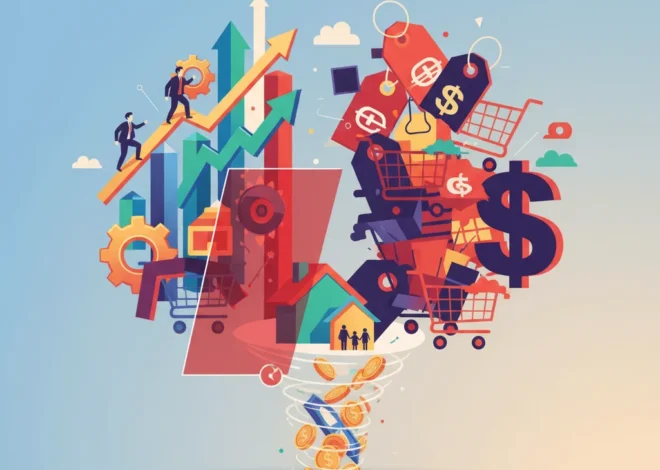
The AI Stock Market Tremor: Are We Witnessing the Start of a Bubble Burst?
Is the AI Gold Rush Over? Decoding the Recent Tech Stock Plunge
The relentless climb of the stock market, largely powered by the meteoric rise of artificial intelligence, has recently hit a significant patch of turbulence. In a move that sent a ripple of anxiety through global financial markets, shares of major technology companies, particularly those at the epicenter of the AI revolution, have fallen in both the United States and Japan. This downturn wasn’t a random market fluctuation; it was driven by a specific and growing fear: that the sky-high valuations of firms linked to AI are not grounded in reality, but are instead the hallmarks of a speculative bubble. According to a recent report from the BBC, these concerns have now translated into tangible losses for investors who have been riding the AI wave.
For months, the narrative has been one of unbridled optimism. Companies like Nvidia, Super Micro Computer, and ARM Holdings became household names among investors, their stock prices soaring to astronomical heights. This wasn’t just a tech story; it was a revolution that promised to reshape every facet of the global economy. But as history has taught us time and again, from Dutch tulips to dot-com domains, periods of euphoric, rapid growth in the stock market are often followed by a painful reckoning. The critical question now facing investors, finance professionals, and business leaders is whether this recent dip is a healthy correction—a moment for the market to catch its breath—or the first tremor before a much larger earthquake.
In this analysis, we will delve deep into the anatomy of this AI-driven market, dissect the arguments for and against the existence of a bubble, draw parallels with the infamous dot-com crash, and explore the broader implications for investing, financial technology, and the future of global economics.
Anatomy of a Sell-Off: Who Got Hit and Why?
The recent market jitters were not indiscriminate. The sell-off was concentrated among the darlings of the AI boom—the companies providing the essential “picks and shovels” for this digital gold rush. While the broader market felt the impact, the pain was most acute for semiconductor firms and hardware manufacturers whose technology underpins generative AI.
To understand the scale of this boom and the subsequent correction, consider the performance of these key players leading up to the dip. Nvidia, the undisputed king of AI chips, saw its market capitalization surge past $2 trillion, a milestone that put it in the same league as giants like Apple and Microsoft. This incredible run was fueled by staggering demand for its GPUs, essential for training large language models. However, even titans can stumble. In a single recent session, Nvidia saw its shares drop over 5%, wiping out over $100 billion in market value in a day—a sum larger than the entire GDP of some countries (source). It wasn’t alone.
Here is a snapshot of the volatility experienced by some of the leading AI-related stocks:
| Company | Role in AI Ecosystem | Recent Market Behavior |
|---|---|---|
| Nvidia (NVDA) | Leading designer of GPUs for AI training | Experienced a sharp one-day decline after a period of unprecedented, near-vertical growth. |
| Super Micro Computer (SMCI) | Builds high-performance servers optimized for AI | Saw its stock price multiply over 10x in about a year before a significant pullback. |
| ARM Holdings (ARM) | Designs energy-efficient processors used in AI applications | Rallied significantly post-IPO before facing downward pressure from valuation concerns. |
| Advanced Micro Devices (AMD) | A key competitor to Nvidia in the AI chip space | Shares also faced a sell-off as sector-wide concerns about a bubble began to mount. |
The “why” behind this sudden shift is a classic case of market psychology meeting fundamental analysis. After such a rapid ascent, investors began to question if the valuations had outpaced even the most optimistic future growth scenarios. The fear is that current stock prices aren’t just pricing in future success; they’re pricing in perfection, leaving no room for error, competition, or macroeconomic headwinds. This is the classic definition of a speculative bubble, where asset prices detach from their intrinsic value, propelled instead by the belief that they will keep rising indefinitely.
The real risk here might not be an “AI bust” but a “valuation correction.” The AI revolution is real, but the market’s timeline for its full economic impact might be compressed. Investors have priced in a decade’s worth of growth into a single year. What we’re seeing is not a questioning of AI’s long-term potential, but a grappling with its short-term price. The fear isn’t that the party is over, but that the market arrived too early and got a little too drunk on the initial hype. For those in the finance and investing world, the challenge is to separate the revolutionary technology from the irrational exuberance it has inspired.
Echoes of 1999: Is the Dot-Com Ghost Haunting the AI Boom?
For anyone involved in trading or the stock market for more than a couple of decades, the current environment feels eerily familiar. The breathless media coverage, the overnight stock market millionaires, and the “this time it’s different” mantra all echo the dot-com bubble of the late 1990s. But while history often rhymes, it rarely repeats itself exactly. A closer look reveals both striking similarities and fundamental differences.
The parallels are undeniable. The dot-com era was fueled by the promise of the internet, a technology that would, and did, change the world. Similarly, AI is a general-purpose technology with the potential to transform every industry from banking to healthcare. In both cases, a speculative frenzy took hold, with investors pouring money into any company associated with the new technology, often with little regard for traditional valuation metrics like the price-to-earnings (P/E) ratio. A 2023 analysis by the asset manager GMO noted that the current market concentration in a few tech giants is even more extreme than it was at the peak of the dot-com bubble (source), highlighting the risk.
However, the differences are just as critical. The table below contrasts the two eras:
| Metric | Dot-Com Bubble (Late 1990s) | AI Boom (2023-2024) |
|---|---|---|
| Profitability | Many high-flying companies were pre-revenue or deeply unprofitable (e.g., Pets.com, Webvan). | The leading companies (Nvidia, Microsoft, Google) are massively profitable with established business models. |
| Market Leaders | Dominated by a mix of established players (Cisco, Intel) and speculative startups. | Dominated by a handful of the world’s largest and most well-capitalized corporations. |
| Technology Maturity | The internet was in its infancy; infrastructure and consumer adoption were still developing. | AI is built on decades of research and is already being deployed at scale with clear use cases. |
| Capital Source | Fueled heavily by retail investor enthusiasm and speculative venture capital. | Fueled by massive corporate investment and institutional capital, in addition to retail interest. |
The key takeaway is that while the market psychology may be similar, the underlying fundamentals of the lead companies are far stronger today. The AI boom is being built on the shoulders of profitable giants, not on the hopeful dreams of fledgling startups. This doesn’t preclude a painful correction, but it may prevent the kind of systemic, multi-year collapse that followed the dot-com bust.
Beyond the Bloodshed: The Economic Collapse of Sudan and Its Global Ripple Effect
The Ripple Effect: Broader Implications for the Economy and Fintech
A significant correction in AI stocks would not occur in a vacuum. The outsized influence of these tech behemoths on major stock indices like the S&P 500 and Nasdaq means that their fortunes disproportionately affect the entire market, including the retirement accounts of millions of ordinary people. A sustained downturn could dampen consumer confidence, reduce corporate spending, and put a chill on the venture capital market that funds the next generation of innovators.
The world of financial technology (fintech) finds itself in a particularly interesting position. On one hand, fintech firms are major consumers of AI, using it for everything from fraud detection and algorithmic trading to personalized customer service in banking. A slowdown in AI development could hamper innovation in this sector. On the other hand, some areas of fintech, like blockchain technology, offer a decentralized alternative to the highly centralized nature of the current AI infrastructure, which is dominated by a few large corporations. A flight from “Big AI” could potentially renew interest in decentralized technologies and their applications.
Furthermore, the global economy is watching closely. Central banks are in a delicate dance, trying to curb inflation without triggering a recession. A tech-led market crash could complicate their efforts immensely. It highlights the interconnectedness of modern finance, where technological hype cycles can have real-world macroeconomic consequences.
Conclusion: Navigating the Hype with a Prudent Strategy
The recent dip in AI-related stocks is a necessary and sobering wake-up call. It serves as a reminder that no asset class goes up in a straight line forever. Whether this is the beginning of a larger bubble bursting or simply a volatile but healthy correction remains to be seen. The evidence suggests that while valuations have become stretched and speculative froth is abundant, the underlying technological revolution is real and transformative.
For investors and business leaders, this moment calls not for panic, but for prudence. The core principles of successful long-term investing become more critical than ever:
- Focus on Fundamentals: Look beyond the hype and analyze the actual earnings, growth prospects, and competitive advantages of companies.
- Diversify: The heavy concentration of market gains in a few AI stocks is a significant risk. A diversified portfolio remains the best defense against sector-specific downturns.
- Adopt a Long-Term Horizon: Attempting to time the market’s short-term swings is a fool’s errand. Investing in transformative technologies like AI should be viewed through a lens of years or decades, not days or weeks.
The AI story is far from over. It will continue to shape our world in profound ways. The challenge for those navigating the financial markets is to embrace the long-term potential of this revolution without becoming a casualty of its short-term speculation.


